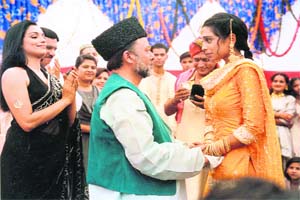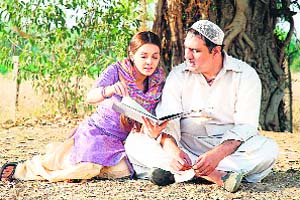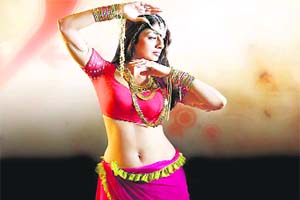|
Neo-wave to new-age
cinema
Followers and
makers of parallel cinema have always been few in number but
realistic, bold and different, like their films, says
Ranjan Das Gupta
|

Vishal Bharadwaj's Maqbool was off-beat and bold

A refreshing comedy like Well Done Abba proves that Shyam Benegal
has not lost his magical touch
|
WHEN
M. S. Sathyuís Garam Hawa was released in 1973, it
created history, as it was the start of the neo-wave cult in
Hindi films. With a taut screenplay by Ismail Chugtai and a
majestic performance by Balraj Sahni, the film set trends,
unknown in the history of Bollywood. Shyam Benegalís Ankur,
Nishant and Manthan followed, establishing the
neo-wave cinema strongly in the tinsel town, where
larger-than-life entertainment and box office-oriented movies
ruled.
Satyajit Ray
welcomed the young Turks like Sathyu and Benegal, describing
them as a promising bunch of directors. He said, "In Bombay
scripts are made, not written. I see a lot of talent and promise
in Sathyu, Shyam and Govind Nihalani, who have changed the
concept of Hindi films quite successfully. I welcome them, and
genuinely feel they can contribute immensely towards good
cinema."
Rayís
statement did not prove wrong. Just as the highly gifted
Buddhadev Das Gupta, Goutam Ghosh, Utpalendu Chakrabarty and
Aparna Sen took up the mantle from Ray, Ghatak and Sen in
Bengal, Nihalani, Saeed Akhtar Mirza and Ravindra Dharmaraj
continued the movement started by Sathyu and Benegal.
They brought a
new phase to the legacy of Dr V. Shantaram, Bimal Roy, Chetan
Anand and Guru Dutt. The 1980s saw a series of off beat, serious
films based on social issues like Akrosh, Chakra and Albert
Pinto Ko Gussa Kyun Ata Hai. These films were cinematically
much richer compared to the stereotypes like Zanjeer,
Pratigya, Sholay and Mehbooba, the potboilers of the
1970s.
Just as the
mainstream cinema saw some of the most forgettable films in the
1980s, the neo- wave cinema prospered with leaps and bounds
catering to the esquire and intelligentsia.
Defining the
neo-wave cinema, Benegal says, "I, and my colleagues, were
looking towards a cinema, neither personal, nor escapist or
theatrical. We decided to explore unknown arenas like the
proletariat movement, milk dairy crisis, and exploitation of the
poor as well as the working class. Of course, the Marxist
ideology inspired us to an extent."
The neo-wave
cinema also gave birth to some highly talented actors like
Naseeruddin Shah, Om Puri, Shabana Azmi, Smita Patil and Amrish
Puri. They filled the vacuum created by the loss of Motilal,
Balraj Sahni, Meena Kumari and Nargis.
|

From left to right: Stills from (above) Ardh Satya, Zubeidaa, Garam Hawa and Aakrosh; and (below) Chandni Bar, Dev D and Luck by Chance
|
Says Nihalani,
"In our earlier films, we sought actors and not stars. A
realistic performance is an actorís prerogative more than a
starís."
Naseeruddin
Shah describes the acting style in films like Manthan and
Akrosh as, "The dhoti clad, nose-picking
people, yelling in protest against the system."
Sathyu, a
former chief assistant of the late Chetan Anand, lost his golden
touch acquired in Garam hawa in Kahan Kahan Se Guzar
Gaya and his later movies. He confesses, "I was never
able to revive my Garam Hawa touch later in my career as
I never received a script of that level."
|

Ram Gopal Varma, Madhur Bhandarkar, Sanjay Leela Bhansali, Anurag Kashyap and Vishal Bharadwaj are the present crop of gifted directors, who are making socially relevant and significant films with realistic touches like Satya, Chandni Bar, Maqbool and Dil Chahta Hai

Dev D, Khosla Ka Ghosla, Luck By Chance and Jail are good examples of the new-age cinema. Most of these films have bold themes and subjects that were not experimented with earlier. Technically, too, much has changed with special effects also adding to the filmsí appeal

|
But both
Benegal and Nihalani continued directing brilliant films and
they had some excellent and bright followers in Ketan Mehta and
Vidhu Vinod Chopra. Watching Holi, Mirch Masala, Sazae Maut
and Khamosh, one can only wonder why Mehta and Chopra
went for unnecessary commercial compromises in their later
films.
The 1990s saw
almost all stalwarts of the neo-wave cinema losing their magical
touch. Benegal could never find his earlier form in Sardari
Begum and Zubeidaa. Nihalani, too, showed signs of
decline in talent in Drishti, Zazere and Takshak.
Though Saeed Akhtar Mirza did show some flashes of brilliance in
Naseem but stopped making films after that.
Analysing the
reasons behind the downfall of the neo-wave cinema, Mrinal Sen
comments, "More than the directors, I will blame the
system, which exists in Hindi films. Bollywood has never
bothered to create an atmosphere for creative cinema or a
thinking audience. The cause for survival and the inner
yearnings to carry on working compelled Benagal, Nihalani and
Mirza to compromise. Of course, they could have done without it
but then it would have made it very difficult for them to
survive in the industry."
Nihalani
agrees, "Times, tastes and audience demands started
changing drastically from the 1990s. The National Film
Development Corporation (NFDC) and other small financers started
paling into oblivion. We had to opt for big-budget films with
famous stars and that required a change in our attitudes to
filmmaking. Of course, Benegal did prove he still has talent
with the refreshing comedies like Welcome To Sajjanpur
and Well Done Abba."
After Satya
and Chandni Bar in the late 1990s, the neo-wave cinema
gave way to the new-age films, the ruling factor in the new
millennium celluloid. Ram Gopal Varma, Madhur Bhandarkar, Sanjay
Leela Bhansali, Anurag Kashyap and Vishal Bharadwaj are the
present crop of gifted directors, who are making socially
relevant and significant films with realistic touches. What is
this new-age cinema? Sanjay Leela Bhansali defines, "It is
the present format of films which is off-beat, realistic and
bold."
The new-age
cinema has seen some brilliant films being made like Satya,
Chandni Bar, Maqbool and Dil Chahta Hai. But in all
honesty these are in no comparison to Ankur, Akrosh or Albert
Pinto`85
Says Madhur
Bhandarkar, "Our films are mainly for a multiplex-oriented
upper-class urban audience. These films are receiving critical
acclaim and financial success undoubtedly. But I must confess
that none of us has been able to deliver a Garam Hawa, an
Ankur or a Tamas. They remain a class apart."
However, Dev
D, Khosla Ka Ghosla, Luck By Chance and Jail are good
examples of the new-age cinema. Most of these films have bold
themes and subjects that were not experimented with earlier.
Technically, too, much has changed with special effects also
adding to filmís appeal.
But does one
remember a single new-age film after coming out of the
auditorium except for a Chandni Bar or a Black Friday?
They pale into oblivion soon and have no repeat value. Even a Lagaan
or a Taare Zameen Par does not command that sort of
respect and following which Garam Hawa, Ankur or Ardh
Satya once did.
Madhur
Bhandarkar, Ashutosh Gowarikar and Anurag Kashyap have,
undoubtedly, created their own audience but not in the manner
Benegal, Nihalani and Mirza did in the late 1970s and 1980s.
Says Mirza,
"I have full confidence in the abilities of Madhur
Bhandarkar and Anurag Kashyap. But they have limited themselves
to creating cinema which only an urban and multiplex-oriented
audience relates to. Small towns and rural India are totally
neglected in their films. So their works never have a perennial
impact."
The new-age cinema may be the
talk of the day but it is certainly not what the neo-wave cinema
was once, a cult cinema. New directors should understand that
form and technical wizardry do not create directors of
substance. The Apu trilogy, Komal Gandhar and Bhuvan
Shome, the earliest stances of neo-wave cinema, have stood
the test of time as they are timeless in theme, treatment and
message. After all, cinema is the greatest medium of art that
needs the touch of the soul, which the new-age cinema has not
yet provided to the fullest extent.
|